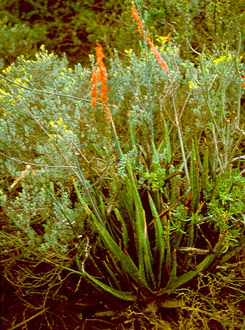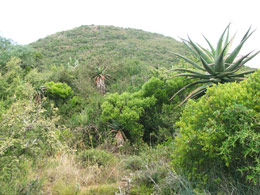Gasteria pulchra
Gasteria pulchra (Aiton) Haw.
Family: Asphodelaceae
Common names: none recorded
Introduction
Gasteria pulchra is a small to medium-sized aloe-like plant bearing narrow and pointed, ascending, dark-mottled green leaves and a loose panicle of pinkish flowers during spring. It is endemic to Albany Thicket vegetation in the Eastern Cape Province. It thrives in cultivation and is easily grown from leaf cuttings or seed.

Description
Description
Plants solitary or proliferating from the base to form small groups, 200-360 mm high, with a very short ascending stem. Roots succulent, up to 3 mm in diameter. Leaves ascending, at first distichous (arranged in two vertical rows on opposite sides of the stem), soon becoming a rosette, 240-360 mm long and 25-40 mm broad at the base, elongated and tapering to a sharp point, almost rounded to triangular in crosssection, plane towards the end (apex). The upper surface distinctly channelled, especially during the dry season. The lower surface somewhat convex, with an indistinct off-centre (eccentric) keel. Both surfaces dark green and with dense white spots arranged in transverse bands. The skin (epidermis) smooth, rarely slightly tuberculate, the margin leathery and bearing minute teeth. Juvenile leaves distichous, tongue-shaped and with a rough, tuberculate surface, ending in a short point.
Inflorescence an ascending, much branched panicle 350-1,500 mm long, rarely simple when plants are smaller. The bracts 10-12 mm long and 4 mm broad at the base; floral bracts 6-7 mm long, 2 mm broad at the base; pedicel 7-8 mm long. The flowers (perianth) 18-25 mm long, tummy-shaped (gasteriform), reddishpink, tube light to dark pink. Capsule 12-27 mm long and 7 mm in diameter. Seeds oblong, 2-5 mm long, 2-3 mm wide, blackish.

Flowering period: Winter to late spring (July to November in the Southern Hemisphere) but with a peak in spring (September-October).
Gasteria pulchra is related to G. nitida which is a smaller grassland plant with much shorter triangular leaves.
Conservation Status
Status
Gasteria pulchra is locally common and currently not threatened.
Distribution and habitat
Distribution description
Gasteria pulchra is quite common in the Hankey and Patensie districts in the Gamtoos Valley and in adjacent regions of the Eastern Cape Province. It is distributed from Studtis, in Baviaanskloof in the northwest, to Hankey in the southeast.

Gasteria pulchra is mainly confined to Gamtoos Thicket which is part of the Albany Thicket vegetation and occurs in hilly terrain which is difficult to penetrate (Mucina & Rutherford 2006). It grows in a succulent-rich community, often among thorny shrubs (nurse plants), small trees and herbs.
Typical small trees and shrubs in the habitat include Portulacaria afra, Boscia oleoides, Cussonia gamtoosensis, Azima tetracantha, Carissa bispinosa and Searsia longispina. Smaller associated succulents in the habitat include Aloe africana, A. ciliaris, Crassula orbicularis, C. perforata, C. pellucida subsp. marginalis, Delosperma echinatum and Senecio pyramidatus.

The climate is hot in summer and mild in winter. The rainfall is 300-400 mm per year and occurs in both summer and winter, but there is a tendency to winter dryness. The geology consists of mainly Enon Conglomerate soil, poor in minerals and slightly acidic. The average annual daily maximum temperature is about 23°C and the average daily minimum about 10°C.
Derivation of name and historical aspects
History
Gasteria pulchra was named by William Aiton in 1789 as a variety of his Aloe maculata in Hortus Kewensis. Adrian Haworth, the British succulent student, in 1804 raised its status to species level. The specific epithet 'pulchra' is derived from Latin (meaning beautiful).
It is not known who first collected Gasteria pulchra, but according to P. Miller (1758) it "was raised from seeds in the Chelsea Gardens (London), which were brought from the Cape of Good Hope by Captain Hutchinson of the 'Godolphin Indiaman'".
Ecology
Ecology
Like most other Gasteria species the plants have passive resistance, with little defence. They turn defeat into victory! The leaves are brittle, and when grazed or trampled, leaf fragments will simply root and establish more plants. This is an effective strategy also adopted by many other Albany Thicket succulents such as Portulacaria afra and various species of other genera of succulents such as Crassula, Adromischus and Senecio.
Gasteria pulchra is pollinated by sunbirds. The succulent leaves and roots enable the plant to cope with dry conditions. The mottled leaves blend in with the natural surroundings, and plants are thus well camouflaged and protected from herbivores. During stress the leaves become reddish. The reddish colour is due to the pigment anthocyanin. This protects the plant during drought and puts a brake on photosynthesis.
Uses
Use
Apart from their horticultural use, the plants are not used medicinally or otherwise.
Growing Gasteria pulchra
Grow
Gasteria pulchra thrives in cultivation (ex situ preservation) and is grown by succulent plant enthusiasts all over the world. It does best as a pot plant or on rockeries in thicket gardens. It also grows well in Mediterranean gardens where frost is not too severe. It is a slow grower, but when grown from cuttings can flower within three years. Plants prefer partial shade, and in hot climates should therefore be protected from full sun.
Propagation
Easily propagated from seed, division or leaf cuttings. It is best to apply a fungicide when growing from seed. Sow seed during spring or summer in a warm, shady position in a sandy slightly acidic soil and keep moist. Cover with a thin layer of sand and keep moist. Germination is usually within three weeks. Seedlings grow slowly and are best planted out about a year after sowing. Propagation from leaf cuttings is best undertaken in spring. Allow the leaf cutting to form a heel by placing it on a dry window sill for a week or three. Cuttings are best rooted in clean sand. Once rooted, plants can be planted into individual containers. Plants react well to organic feeding (compost or any other liquid fertilizer). Gasteria pulchra is best watered throughout the year, but sparingly in winter.
References
- Mucina, L. & Rutherford, M.C. (eds) 2006. The vegetation of South Africa, Lesotho and Swaziland. Strelitzia 19. South African National Biodiversity Institute, Pretoria
- Van Jaarsveld, E.J. 1994. Gasterias of South Africa. Fernwood Press, Cape Town.
- Van Jaarsveld, E.J. 2007. The genus Gasteria, a synoptic review. Aloe 44, 4: 84-103.
Credits
Ernst van Jaarsveld
Kirstenbosch National Botanical Garden
March 2012
Plant Attributes:
Plant Type: Succulent
SA Distribution: Eastern Cape
Soil type: Sandy, Loam
Flowering season: Spring
PH: Acid
Flower colour: Pink
Aspect: Shade
Gardening skill: Easy
Special Features:
Horticultural zones








Rate this article
Article well written and informative
Rate this plant
Is this an interesting plant?
Login to add your Comment
Back to topNot registered yet? Click here to register.